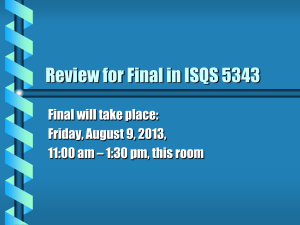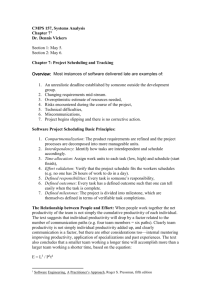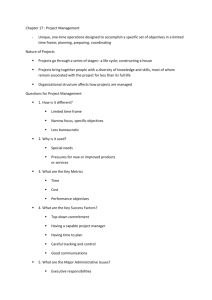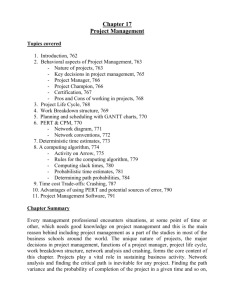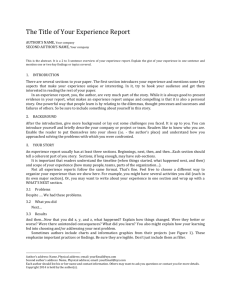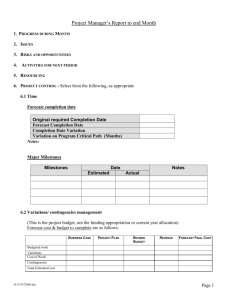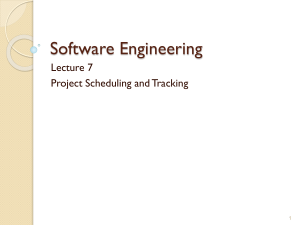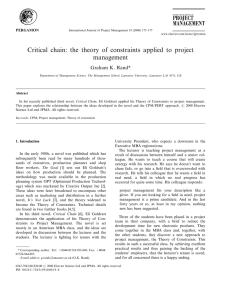Review for Final
advertisement
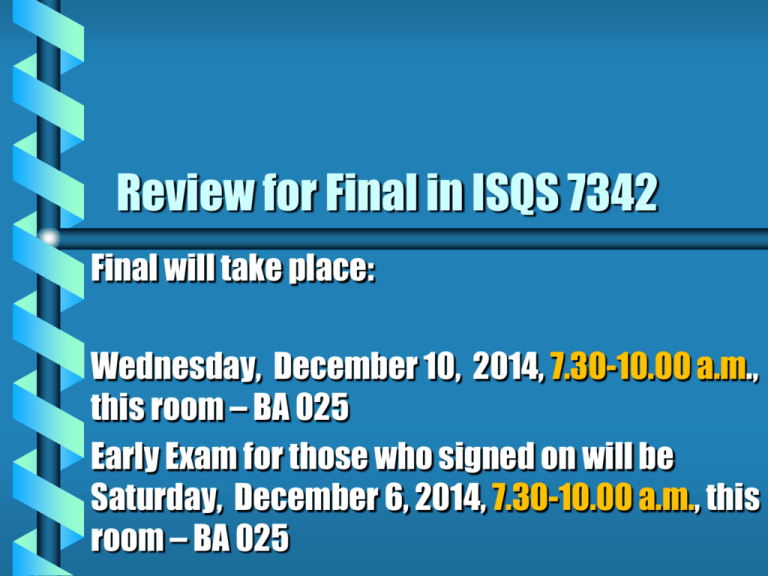
Review for Final in ISQS 7342
Final will take place:
Wednesday, December 10, 2014, 7.30-10.00 a.m.,
this room – BA 025
Early Exam for those who signed on will be
Saturday, December 6, 2014, 7.30-10.00 a.m., this
room – BA 025
Format
75-100 multiple choice worth 75%
2-3 discussion problems worth 25%
exam is closed notes/closed book
Exam will be comprehensive
• 70% of the exam will cover material since
Exam 2
• 30% of the exam will cover prior material
No talking during the EXAM, please
Bring
Pencils/Eraser
Calculator
Orange Scantron sheet
Emphasis will be upon:
Human Resource Management
Risk Management
Procurement Management
Communications Management
Goldratt Concepts
Finishing Projects Fast
Possible Discussion Questions
Name ten characteristics of a project
Successful project management entails
what exactly (4 ‘measures’)
Name the stages of the project lifecycle
• Show their sequence
Why is project management important
Name the four core knowledge areas
Name the five facilitating knowledge areas
More discussion questions
What is the tenth knowledge area and what
is its purpose
Name some things we do poorly in projects
What term do we use to describe an event
at which a major deliverable is completed?
What device or construct is often used to
initiate a project?
What steps are used to launch critical
chain project management?
Typical discussion problems
Construct an activity on node network chart from
a table; Determine duration, ES, EF, LS, LF and mark
the critical path
Perform earned value analysis: BCWP, BCWS,
ACWP, CV, SV, EV, PV, AC, CI, SI
Perform crashing of networks
What are the five phases that make up the CMMI?
Illustrate the tradeoff triangle
Assuming that half the durations are safety,
redraw a project network showing all feeding and
project buffers and their lengths
Multiple choice
Risk, Procurement, HR, and
Communications knowledge mangement
Chapters 12, 14 of Burns
Process maturity slides
Finishing projects fast slides
Critical chain concepts
Why has Project Management
become so in-vogue?
Diversity of new products and product
markets
Shorter life span of products
Rapid technological changes
What are the major reasons for
project failure?
Inadequate conceptualization and
definition
• Specifically, inadequate requirements
Absence of a plan
Unavailable resources when needed
Scope and hope creep
Unresponsive contractors who deliver their
product late
What are the five stages of the
project lifecycle?
STAGE 1:
Initiating
STAGE 2:
Planning
STAGE 3:
Executing
STAGE 5:
Closing
STAGE 4:
Monitoring-and-Controlling
In which of these stages is a WBS
started?
Initiating (Conceptualizing and Defining)
• First 3 levels
{The WBS is usually finished in the
Planning and Budgeting stage}
What are the ten knowledge
areas?
Scope
Risk management
management
Time management
Cost management
Quality
management
Procurement
Integration
management
management
Human resource
management
Communications
management
Stakeholder
Management
In which stage is scope
management most important?
The first stage:
Initiating
(Conceptualization and Definition) because
that is where scope is defined
Activity Definition (Define Activities)
is ___
a subproject
a process
a problem
a plan
WHICH???
Activity Definition (Define Activities)
is part of what knowledge area?
Time management
Project Scope Management
Processes
Collect Requirements
Define Scope
Create WBS
Verify Scope
Control Scope
Project Time Management
Processes
Define Activities
Sequence Activities
Estimate Activity Resources
Estimate Activity Durations
Develop Schedule
Control Schedule
Project Cost Management
Processes
Estimate Costs
Determine Budget
Control Costs
Project Quality Management
Processes
Plan Quality
Perform Quality Assurance
Perform Quality Control
The main purpose of a project
plan is to ____
acquire resources
guide project execution.
meet standards expectations.
reduce risk.
The most important output of
project execution is
Not---change requests
Not—the WBS
Not—project plan
Not—requirements doc
But—work products—the
deliverables of the project
The Principle…
That work tends to fill up the time allotted
for it is known as…..
Most core knowledge areas have a
Planning process
And a
Control process
During the …
Conceptualization and definition stage, it is
important that the project manager get
What are the five steps of the
Theory of Constraints (Goldratt)?
IDENTIFY the project constraint
Decide how to EXPLOITE that constraint
SUBORDINATE everything to that decision
ELEVATE the system’s constraint
Go back to step a
NOT…
SUBORIDNATE that decision to everything
else
According to Goldratt…
Team players put too much ____ into their
estimated durations
As Goldratt sees it, ….
The ultimate constraint in projects is….
Which of the following does Goldratt
regard as a positive thing
Safety
Multitasking
Student syndrome
Lose/lose contracting
None of the above
An activity has probabilistic
completion times of 20, 50 and 80
for the optimistic, most likely and
pessimistic durations.
What is the average time (duration)
assuming a beta distribution?
30
40
50
60
70
You should know
How to construct a NETWORK chart from a
table
How to construct a Gantt chart from a table
How to perform NETWORK crashing
How to do EVA
A work package…
Has $100,000 budgeted for it
Is 50% complete
What is its BCWP = EV??
$30,000
$40,000
$50,000
$60,000
A task with a $10,000 budget has a
start date in the future
Its BCWS (planned value) is
•
•
•
•
$0
$5,000
$10,000
Can’t be determined
A task with a $10,000 budget has a
stop date in the past.
Its BCWS (planned value) is
•
•
•
•
$0
$5,000
$10,000
Can’t be determined
A task with a $10,000 budget and a 6
day duration has just finished day 3
Its BCWS = PV is
•
•
•
•
$0
$5,000
$10,000
Can’t be determined
A task has a budget of $20,000 and a
scheduled duration of 5 days
What is its daily burn rate?
$4,000
What is its PV rate?
$4,000
If the project is 20% complete what is its
BCWP?
$4,000
A task has a budget of $20,000 and a
scheduled duration of 5 days
What is its PV rate? $4,000
If the project is 20% complete what is its
BCWP? $4,000
If day three has just transpired, what is the
BCWS? $12,000
What is the task’s SV (schedule variance)?
-$8,000
Is the task ahead or behind schedule???
Questions about MS Project
Which key for subordination?
• The Indent arrow
Which key for linking, for sequencing?
• The linking tool
How to view project duration and cost on
the project information dialog box?
• Click on the Project tab and then the Project
Information Icon
Questions about MS Project
How to see all of the cost and duration
detail in the entry table in the ? view,
including total PROJECT cost and duration
How to see all of the activity costs
For MS Project to cost your
project, it needs to know
Resource hourly costs
• Specified in what view????
– The Reource sheet
Activity fixed costs
• Specified on the Cost table
THIS IS ALL
In MS Project, durations/costs of
phases (summary tasks) …..
Containing one or more subordinate tasks
can be specified only by MS Project
Is it a good idea to assign resources to
summary tasks as well as to subordinate
tasks?
Summary Tasks…..
Always appear in black or in blue?
Occur when….
There are tasks subordinate
to it
Task info is entered in which
view of MS Project, usually??
The Network View
The Gantt view, using the Entry Table
The Resource Sheet
The Tracking Gantt view
When using the standard
calendar, MS Project assumes
a.
b.
c.
d.
8-hour work days
No work on Sat or Sun
Two persons can do the work in half o f the
time
All of the above
Questions over CRITICAL CHAIN
Major conclusions, recommendations
Goldratt’s view of EVA
What to Measure
What to Focus on
More Questions on CRITICAL
CHAIN
To avoid non critical paths from becoming
critical you should…
Critical chain is the sequence of tasks
performed by key persons both on and off
the critical path
Measurements should
Induce the parts to always do what is good
for the system as a whole
Why does Goldratt not like BCWP,
BCWS, ACWP?
Because they have no sensitivity to the
critical path
If you have a task on the critical
path and …..
Your time to complete that task has arrived,
then Goldratt recommends that you drop
everything and just focus (150%) on
that task until you get it done!!
• No multitasking
• No procrastination (student syndrome)
Project Performance
Measurement and Control
The first step is to….
SET A BASELINE….
The second step is to
MEASURE PROGRESS AND PERFORMANCE
The third step is to
COMPARE PLAN AGAINST PERFORMANCE
Project Performance
Measurement and Control
The last step
is
TAKE APPROPRIATE ACTION
Project schedule status is usually
communicated with a
Tracking Gantt Chart showing a progress
line
Notes on shortening project
durations
This should be done in the Planning and
Budgeting stage
Crashing
• Reducing the duration of tasks on the critical path
Fast-tracking
• Starting tasks sooner
Adding resources??
Checking for parallelism opportunities in the
schedule
• Pull as much work off of the critical path as you can
More Tips on shortening project
durations
REUSE, REUSE, REUSE
Do it right the first time
Avoid enhancements to requirements
Instead,
consider scrubbing requirements
(reducing scope)
If its early in the project, consider
• outsourcing some project work
• Adding resources in-house
• Using overtime
More techniques for shortening
projects
Scrub the requirements, as we mentioned
• Remove from the requirements those items that add
little or no value, but nevertheless are significant
contributors to cost
• Remember the Pareto principle—80% of the value
comes from 20% of the functionality
Do everything right the first time (AGAIN)
REMOVE SAFETY--GOLDRATT
Crashing Problem (Burns, Ch. 8)
For the network diagram below, find the best crashing strategy
considering that you have $1300 in the crashing budget and the
following:
10
22
B/12
10
0
D/13
0
22
Task
35
22
0
35
10
35
0
A/10
0
22
42
0
F/7
10
35
10
20
C/10
15
20
25
PATHS
ABDFG
ABDG
ACEFG
ACEG
BUDGET SPENT
BUDGET LEFT
25
42
52
42
5
52
Minimum
duration
8
10
8
10
6
5
6
Duration
10
12
10
13
10
7
10
Note from above that A can only be crashed
2 days, from 10 down to 8 days, etc.
35
LENGTH
(Days)
52
45
47
40
0
$1,300
0
G/10
30
E/10
5
42
A
B
C
D
E
F
G
Crash
cost/day
$200
$300
$300
$400
$400
$350
$100
CRASH G
6 Days
46
39
41
34
$600
$700
CRASH A
2 Days
44
37
39
32
$400
$300
CRASH B
1 Day
43
36
39
32
$300
$0
Network diagrams, drawn by
commercial software
Do they use
• Activity-on-Node, or
• Activity-on-Arrow representations?
That’s all folks
{I enjoyed having you as a class—one of
the best classes I’ve had)
